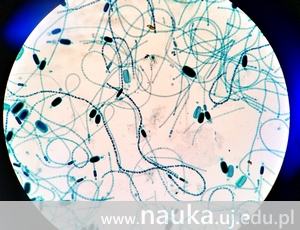
Are we about to witness a major breakthrough in science and start producing hydrogen using microorganisms? Dr Dariusz Dziga from the JU Faculty of Biochemistry, Biophysics and Biotechnology answers our question.
1Question is a series of articles by the University Marketing science communication unit, in which specialists and experts from various fields briefly discuss interesting issues related to the world, civilisation, culture, biology, history, and many more.
Scientists universally agree that we need to work on renewable energy sources. We harness rivers to propel turbines, we construct massive wind farms, we cover large patches of land with solar batteries. We build more and more of those, but we still use huge amounts of fossil fuels.
However, maybe we should engage in small scale fuel production? Microscale, to be precise. We already use microorganisms (such as bacteria or algae) for various purposes, from producing food and alcohol to creating advanced medicine.
To harness a microscopic element
As with almost every new technology, everything began by mimicking nature. We know that plants, algae and cyanobacteria use sunlight to synthesise organic compounds through the process of photosynthesis. One of its key stages is the water photolysis, i.e. the moment when water is broken down into electrons and cations. Next, these components are used as "power cells" during the formation of organic compounds. At the same time, electrons and cations, released from water, can also be turned into hydrogen. This type of reactions are catalysed by enzymes known as the hydrogenases. The process is amazingly simple: breaking down water particles and using electrons made during photolysis to reduce hydrogen ions.
Apart from this most basic model, we can also produce hydrogen in a number of different ways, for instance with the use of nitrogenises – enzymes which bind atmospheric nitrogen. In most of these methods, light is used to separate electrons and protons. It is also possible to acquire them from simple organic compounds – it is effectively done by photosynthetic purple bacteria.
What next?
So what stops us from producing large amounts of hydrogen using these methods? The problem is that over 2 billion years of evolution have shaped these photosynthetic organisms so that hydrogen is not indispensable to them – it is important, but not crucial. Therefore, scientists need to concentrate on increasing the effectiveness of production. But why should we invest in this kind of research, when we already know how to produce biodiesel and bioethanol? When we take a closer look at the resources needed, the answer will be clear.
To produce biofuels based on plant material, we need very large, fertile fields. But, we also need them to grow food and to enable degradation of natural ecosystems. Conversely, the only things we need to produce hydrogen is water (or seawater) and sunlight as well as some carbon dioxide and mineral salts to help accelerate biomass growth. It seems, then, that microbiological production of hydrogen from water is a great opportunity – not only for scientists, but the whole world.





